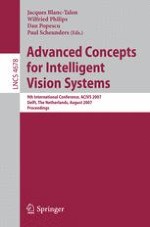2007 | Buch
Advanced Concepts for Intelligent Vision Systems
9th International Conference, ACIVS 2007, Delft, The Netherlands, August 28-31, 2007. Proceedings
herausgegeben von: Jacques Blanc-Talon, Wilfried Philips, Dan Popescu, Paul Scheunders
Verlag: Springer Berlin Heidelberg
Buchreihe : Lecture Notes in Computer Science
